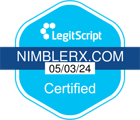


Building an Acne-Prevention Skincare Routine
February 29, 2024
Although you may associate acne with puberty, it’s a very common skin condition that can affect patients of all ages — and every age group and skin type needs a unique routine to combat it!
Getting your acne-fighting routine right is essential to improving the look of your skin and preventing scarring or damage to your skin. Establishing a consistent routine that’s designed for your skin can help manage breakouts, reduce inflammation, and promote clearer, healthier skin.
It’s important to discuss your needs with your doctor or dermatologist before making any changes to your regimen. Let’s dive into the basics of a well-rounded skincare routine.
Step 0: Makeup Removal
This optional step is for those who wear makeup or other cosmetic products. It can be helpful to take off makeup before cleansing with micellar water or a cold cream designed to break up and gently remove cosmetic products. By getting rid of most of the makeup on your face in this step, you can help your cleanser work more effectively at getting deep into your pores.
Step 1: Cleansing
Start your skincare routine with a gentle cleanser specifically formulated for acne-prone skin. Look for cleansers that contain ingredients like salicylic acid or benzoyl peroxide, known for their ability to unclog pores and combat acne-causing bacteria.
Avoid harsh scrubs or abrasive cleansers, as they can irritate the skin and worsen acne. There are also lots of cleaners on the market designed for sensitive skin if you’re easily irritated. After visiting with your dermatologist, they might also prescribe a more powerful cleanser if needed.
Step 2: Exfoliation
Regular exfoliation helps remove dead skin cells, unclog pores, and promote skin renewal. It’s popular to ppt for chemical exfoliants such as alpha-hydroxy acids (AHAs) or beta-hydroxy acids (BHAs), like glycolic acid or salicylic acid. These ingredients gently exfoliate the skin without typically causing irritation.
However, limit exfoliation to 1-2 times per week to prevent over-exfoliation, which can lead to dryness and inflammation of the skin.
Step 3: Targeted Treatment
To address active acne (or inflamed pimples/ bumps), consider incorporating targeted treatments into your routine. Targeted treatments known as acne “spot treatments” containing benzoyl peroxide or sulfur can help reduce the size and redness of individual pimples.
Retinoids, available in prescription or over-the-counter strengths, can also be effective in preventing clogged pores and reducing inflammation. However, always consult a dermatologist before using retinoids.
Step 4: Hydration
Hydrating your skin is essential, even if you have acne-prone skin. Look for lightweight, oil-free moisturizers that won't clog pores or exacerbate acne.
Non-comedogenic moisturizers with ingredients like hyaluronic acid or ceramides can help maintain the skin's moisture barrier without adding unnecessary oil. Consistently using moisturizer both day and night can improve your complexion and ensure your freshly cleansed skin remains protected.
Step 5: Sun Protection
Protecting your skin from harmful UV rays is crucial, especially when using acne treatments that may increase sun sensitivity. It’s generally recommended to use a broad-spectrum sunscreen with an SPF of 30 or higher and apply it generously to all exposed areas of your skin, even on cloudy days.
Look for oil-free or non-comedogenic sunscreens to avoid pore congestion that can cause breakouts or irritation.
Step 6: Take a Hands-Off Approach
Avoid touching your face throughout the day to minimize the transfer of bacteria and prevent further irritation. Picking or squeezing pimples can lead to scarring and prolong the healing process.
Keep your hands clean for instances when you do touch your face, and if necessary, use non-comedogenic makeup to cover blemishes.
Developing a skincare routine tailored to acne-prone skin can significantly improve the appearance and overall health of your skin. Make sure to consult with a dermatologist for personalized advice on building your regime before making any purchases or starting new treatments.






.png)





















.jpg)

















.jpg)


























.jpg)
.jpg)
.jpg)























.jpg)
.jpg)

